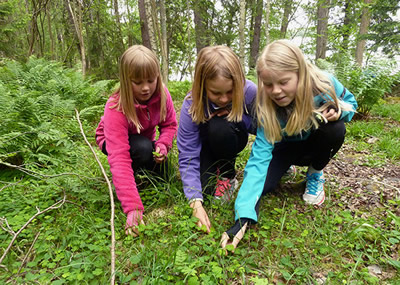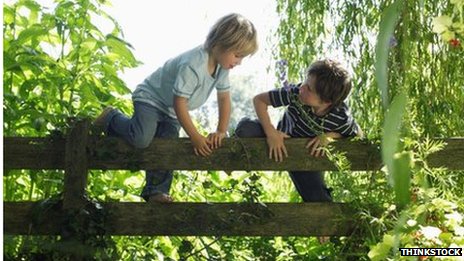Lesson 7: Planning Play
Attention

How do educators plan for play that provides children with much enjoyment and learning about nature?

Learning Outcomes
Upon completion of this lesson's material
- Students will discuss the Value of Play
- Students will discuss setting up environments that allow for play
- Students will discuss how to plan for play
- Students will discuss how to facilitate play
Teaching
Research has shown that preschoolers who experience child initiated, free choice activities that are supported through intentional play will have better cognitive and language performance at seven years old than same aged peers without similar experiences. Other supporting research shows pretend play strengthens sustained attention, memory, logical reasoning, language and literacy skills, imagination, creativity, understanding of emotions and the ability to reflect on one’s own thinking, impulses, control of own behavior, and ability to take another’s perspective.
According to the American Academy of Pediatrics (2007) “Play is essential to develop because it contributes to cognitive, physical, social, and emotional well-being of children and youth.” Psychiatrists and psychologists are concerned about the raising stress and anxiety levels in children saying, “Limiting free play in kids may result in a generation of anxious, unhappy and socially maladjusted adults.” Another study showed a concern between bullying behavior in adolescents: “Some psychologists are concerned that one cause may be ‘less playtime in kindergarten and pre-school’ where children learn to get along with other children through play experiences.”
Something to think about: So with all this research showing the importance of play: Why is it so difficult to observe sustained play in many preschool setting?
Play as a Curriculum
- Make clear the connection between research to learning and play
- Teaching strategies used to facilitate play need to aid in the same connection
- Create essential planned time for sustained high-level play to development
- While planning this time, remember that this time can allow for child-initiated play: Time to resolve conflicts, problem solve, negotiate with peers, and for children to experience several roles in the play
Setting up the Environment
- Well organized environment
- Rich possibilities for exploration and play
- Clearly defined places for materials to be replaced-pictures and words
- Materials & toys uses are explained w/ guidance offered as reminders
- Learning centers are set-up as separate spaces
- Shelving and tables aid in defining the spaces
- Baskets and bins are used to store material
- Consider traffic flow and noise levels
- Group loud areas together and quiet areas further away
- Place messy areas near water sources
- Are there areas for individual, small group and large group play?
- Are their soft and hard surfaces as well as other textures available?
Once a classroom environment is designed, consider the following questions:
- What organization strategies were used?
- Are there any potential problems with traffic flow?
- Are there any changes that need to be made?
- Are there ample play materials? Do they need to be rotated?
- Do you need to do a Time Sample observation to track where and how many children are playing in specific areas?
- Are the learning area spaces too large? Too small?
- Should there be a specific number of children in a specific area?
- If so, how will the children know this information?
- Are children’s lives (culture, family type) and interests represented throughout the room?
- Are children functioning as independently as possible?
- Are children displaying disruptive behavior or boredom?
- After reflecting on the above questions, what changes may need to be made?
- Does a new planning framework need to be prepared?
- Should new toys/materials be introduced to children?
- Are adults available to offer guidance as needed?
- Do children know how to use the materials productively?
- Does a specific child’s needs or goals need to be addressed in a different way?
- Is there enough time for high-level play to develop?
Something to think about: During a recent observation, I asked a child why he was sitting in the block area without building. He responded to me “the block area is my favorite place.” I asked him what he liked to build. He replied “oh I don’t build here, I just think here.” When I asked him why he didn’t build there he replied, “I don’t build here because after I think, it is time to pick up. I build at home.” What does this say about providing enough time for high-level play?
As an educator, it is important to plan for high-level play:
- Preschoolers become socially competent with lots of extended times to interact with one another
- They decide where to pla
- Whom to play with
- What they will do in that area
- Planned time for extended play is considered an essential developmental investmen
- Educators may enhance the level of play by interacting in a supportive manner
- Educators can honor what children are doing, introduce new vocabulary, and ask open-ended questions
- Educators facilitate children’s growing attention spans so play becomes richer and more rewarding, ripe with learning opportunities
Acting as Play Facilitators
Educators become facilitators – scaffolding and assisting children, stepping in and out of children’s play. Teachers must be watchful, observing children carefully to know when to get involved and what strategies to use to enhance play. As a facilitator of high level play, preschool teachers can:
- be enthusiastic cheerleaders
- be questioning, challenging or provoking
- be mediators or equipment suppliers
- be a quiet presence nearby, observing, listening, and ready to step in when invited or needed.
- PLEASE notice none of these advocate taking over children’s play
Facilitators:
- Acknowledges what children are saying or doing
- Encourage children’s efforts
- Give specific feedback
- Model attitudes, problem solving and behavior towards others
- Demonstrate the correct way to do something
- Be aware of children’s suggestions and respond appropriately
- It may be the correct way until they show you another “correct” way
- Be aware of children’s suggestions and respond appropriately
- Create or add challenge
- Ask questions that provoke children’s thinking
- Offer assistance
- Provide information
- Give directions
Scaffolding
Scaffolding provides support that helps a child do something that she could not quite do on her own. The help is temporary, only needed until she is confident and skilled at the task attempted. Lev Vygotsky calls this the zone of proximal development (ZPD). To learn more about ZPD, please go to the following link:
As a preschool teacher using scaffolding it is important to
• Know what a child is capable of doing (cognitive functioning)
• Know what supports will be successful (learning style)
• Determine how much challenge is needed
• Know who to pair each child with for greater learning to take place
• Which adult will fit with the child for a positive interaction
This chapter has offered many suggestions and strategies for planning play. There are many questions a preschool teacher needs to consider when planning play, observing play, reflecting on play and making adjustments to enhance children’s learning and play
Assessment
Lesson 7 Discussion
What have you done to promote play (or fun) in your own life, your child’s life, your classroom or your current work site?
Lesson 7 Quiz
- Explain the benefits of high-level play.
- Look at the list of resources for organizing an environment found on pg. 108, research one of them and write a summary of what you discovered.
- Discuss three ways you may plan for play.
- List five ways you have facilitated play
- Describe how you would guide (scaffold) a child who is learning to tie his shoe.